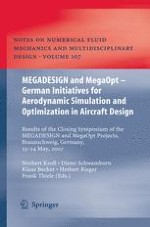2009 | Buch
MEGADESIGN and MegaOpt - German Initiatives for Aerodynamic Simulation and Optimization in Aircraft Design
Results of the closing symposium of the MEGADESIGN and MegaOpt projects, Braunschweig, Germany, 23 - 24 May, 2007
herausgegeben von: Norbert Kroll, Dieter Schwamborn, Klaus Becker, Herbert Rieger, Frank Thiele
Verlag: Springer Berlin Heidelberg
Buchreihe : Notes on Numerical Fluid Mechanics and Multidisciplinary Design
